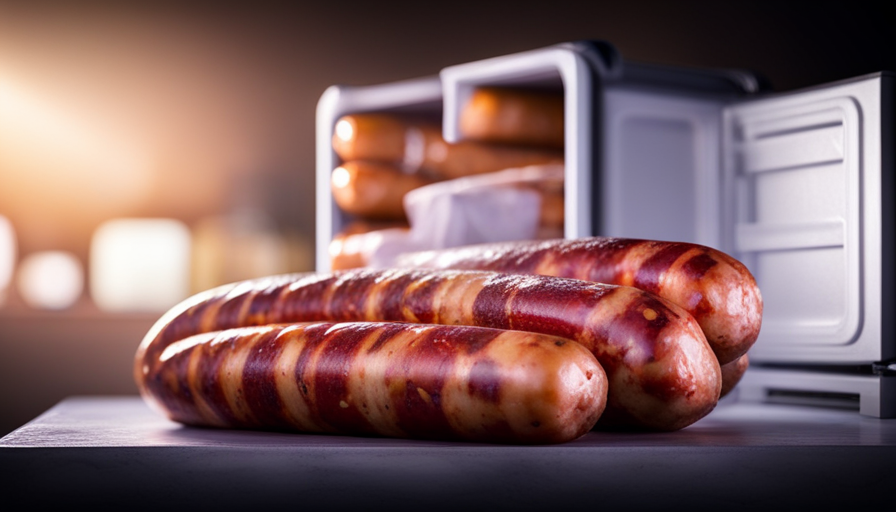Have you ever considered how long your raw sausage will remain fresh and safe to consume? Think of your raw sausage as a ticking time bomb, waiting to release bacteria if not handled and stored correctly. This article will lead you through the important aspects of food safety concerning raw sausage, allowing you to savor your meals without any concerns.
Proper storage is crucial in preserving the quality and safety of raw sausage. But how long can you keep it before it becomes a breeding ground for harmful microorganisms? We will explore the shelf life of raw sausage and the signs that indicate it has gone bad.
Additionally, I will share safe handling practices and common mistakes to avoid, as well as the factors that can affect the shelf life of your sausage.
So, if you want to prevent any foodborne illnesses and make the most out of your raw sausage, join me on this journey to learn about extending its shelf life and the essential food safety tips for buying it. Remember, knowledge is power when it comes to keeping your food safe!
Key Takeaways
- Raw sausage should be stored below 40°F (4°C) to prevent bacterial growth.
- Proper packaging, such as airtight containers or sealed packaging, can extend the shelf life of raw sausage.
- Freezing raw sausage can further extend its shelf life.
- Cook raw sausage to an internal temperature of 160°F (71°C) to kill bacteria.
Proper Storage of Raw Sausage
When properly stored, raw sausage can keep for a significant amount of time, ensuring that you can enjoy it safely and without any concerns about foodborne illnesses. The key to prolonging the freshness of raw sausage is to store it at the right temperature and in the right conditions.
It is important to keep raw sausage refrigerated at a temperature below 40°F (4°C) to prevent bacterial growth. This means that after purchasing raw sausage from the store, it should be promptly placed in the refrigerator.
To further prevent bacterial growth, it’s recommended to store raw sausage in its original packaging or in a tightly sealed container to avoid cross-contamination with other foods.
Additionally, it’s important to be mindful of the expiration date on the packaging and consume the raw sausage before that date to ensure its freshness.
By following these storage guidelines, you can safely enjoy raw sausage for an extended period of time.
Now let’s move on to the next section and discuss the shelf life of raw sausage.
Shelf Life of Raw Sausage
Typically, raw sausage has a limited shelf life before it starts to spoil. It is important to know how long you can keep raw sausage to ensure food safety. The shelf life of raw sausage can vary depending on factors such as the type of sausage, storage conditions, and whether or not it has been frozen.
To give you an idea of how long raw sausage can last, here is a table comparing the storage times for different types of raw sausage:
| Type of Raw Sausage | Refrigerator Storage Time | Freezer Storage Time |
|---|---|---|
| Fresh Sausage | 1-2 days | 1-2 months |
| Smoked Sausage | 1 week | 1-2 months |
| Italian Sausage | 1-2 days | 1-2 months |
Freezing raw sausage can extend its shelf life significantly. It is best to freeze raw sausage in airtight packaging or freezer bags to prevent freezer burn. When you are ready to use the sausage, thaw it in the refrigerator before cooking.
When cooking raw sausage, it is important to ensure that it reaches a safe internal temperature of 160°F (71°C) to kill any harmful bacteria. There are various cooking methods for raw sausage, such as grilling, baking, or pan-frying, each offering a unique flavor and texture.
Knowing the shelf life of raw sausage and the proper cooking methods is crucial for maintaining food safety. In the next section, we will discuss the signs of spoiled raw sausage.
Signs of Spoiled Raw Sausage
It’s important to recognize the telltale signs of spoiled sausage to avoid any unpleasant surprises. Here are some signs that indicate your raw sausage has gone bad:
-
Foul Odor: Spoiled raw sausage will have a strong, unpleasant smell. If it smells rotten or sour, it’s best to discard it.
-
Discoloration: Look out for any changes in color. If the sausage appears gray, greenish, or has patches of mold, it’s a clear sign that it’s spoiled.
-
Sliminess: Fresh raw sausage should have a slightly sticky texture, but if it feels slimy or sticky, it’s a sign of bacterial growth and shouldn’t be consumed.
-
Texture Changes: If the sausage feels dry or has a mushy consistency, it may have spoiled and isn’t safe to eat.
Consuming spoiled raw sausage can lead to foodborne illness, causing symptoms like nausea, vomiting, diarrhea, and stomach cramps. To avoid this, it’s crucial to handle and store raw sausage properly.
Transitioning into the next section about safe handling practices, it’s essential to follow these guidelines to ensure the safety of your food.
Safe Handling Practices
To ensure your sausage stays fresh and free from contamination, always wash your hands thoroughly before and after handling it. Raw sausage can contain harmful bacteria such as Salmonella or E. coli, so proper handling is essential to prevent foodborne illnesses. When preparing raw sausage, it is important to follow safe practices to minimize the risk of contamination.
Here are some guidelines for safe handling of raw sausage:
- Keep raw sausage refrigerated at a temperature below 40°F (4°C) until ready to use.
- Use separate cutting boards and utensils for raw sausage to avoid cross-contamination with other foods.
- Cook raw sausage to an internal temperature of 160°F (71°C) to kill any bacteria present.
- Promptly refrigerate any leftovers within two hours of cooking.
By following these practices, you can reduce the risk of foodborne illnesses associated with raw sausage. Remember, proper preparation and cooking temperatures are key to ensuring the safety of your food.
Next, let’s discuss common mistakes to avoid when handling raw sausage.
Common Mistakes to Avoid
Make sure you don’t cut corners when handling your sausage to avoid any slip-ups that could lead to contamination. Common mistakes when it comes to safe handling can easily be avoided with a little extra care.
Firstly, one of the most common mistakes is not washing your hands before and after handling raw sausage. This is a crucial step to prevent the spread of bacteria.
Another mistake is using the same cutting board and utensils for raw sausage and other foods without proper cleaning in between. Cross-contamination can easily occur this way.
Additionally, many people fail to properly store raw sausage in the refrigerator. It should always be kept at a temperature below 40°F (4°C) to slow down bacterial growth.
Lastly, some individuals make the mistake of tasting raw sausage to check for seasoning. This is highly risky, as it can lead to foodborne illnesses.
By avoiding these common mistakes, you can ensure the safety of your sausage and prevent any potential health risks.
Now, let’s move on to storage tips for leftover cooked sausage.
Storage Tips for Leftover Cooked Sausage
If you’ve got some leftover cooked sausage, here’s a handy tip to ensure it stays fresh and tasty for your next meal: store it in an airtight container in the refrigerator. This simple step will help to prevent any bacteria growth and keep your sausage safe to eat.
To give you a better idea of what you can do with your leftover cooked sausage, here are three ideas:
-
Reheat it: You can simply heat up the leftover sausage in a skillet or microwave until it’s hot all the way through. This is a quick and easy way to enjoy it again.
-
Make a breakfast scramble: Chop up the leftover sausage and add it to a pan with some eggs, vegetables, and cheese. Cook it all together for a delicious and hearty breakfast option.
-
Create a pasta dish: Slice the leftover sausage and toss it with cooked pasta, vegetables, and your favorite sauce. This is a great way to use up leftovers and create a flavorful meal.
By following these tips, you can make the most out of your leftover cooked sausage. Now, let’s move on to the next section where we’ll discuss the factors that affect the shelf life of raw sausage.
Factors That Affect Shelf Life
Are you wondering what factors can impact how long your sausage stays fresh? Understanding the shelf life factors and best storage practices is essential for ensuring the safety and quality of your raw sausage.
Several key factors affect the shelf life of raw sausage, including temperature, packaging, and handling.
Temperature plays a crucial role in preserving the freshness of raw sausage. It’s important to store it at a temperature below 40°F (4°C) to inhibit bacterial growth. If the sausage is kept at higher temperatures, such as in the danger zone of 40°F to 140°F (4°C to 60°C), bacteria can multiply rapidly, leading to spoilage.
Packaging also plays a significant role in extending the shelf life of raw sausage. It’s recommended to store sausages in airtight containers or sealed packaging to prevent exposure to air, which can accelerate spoilage. Vacuum-sealed packaging is particularly effective in preserving the freshness and flavor of the sausage.
Proper handling practices are equally important in maintaining the quality of raw sausage. Avoid touching the sausage with bare hands to minimize the risk of contamination. Additionally, always wash your hands and utensils thoroughly before and after handling raw sausage to prevent the spread of harmful bacteria.
Understanding these shelf life factors and implementing best storage practices can help extend the freshness of your raw sausage. By following these guidelines, you can ensure that your sausage stays safe to consume for a longer period.
Now, let’s explore ways to further extend the shelf life of raw sausage.
Extending the Shelf Life of Raw Sausage
Now, let’s delve into ways you can further prolong the freshness of your sausage. Here are some best practices for storing raw sausage:
-
Keep it refrigerated: Raw sausage should always be stored in the refrigerator at a temperature below 40°F (4°C). This helps slow down the growth of bacteria and extends its shelf life.
-
Use proper packaging: Transfer the sausage from its original packaging to an airtight container or wrap it tightly in plastic wrap. This prevents air and moisture from entering, which could lead to spoilage.
To further extend the shelf life of your raw sausage, you can also consider freezing it. Here’s how:
-
Wrap it well: If you plan to freeze the sausage, make sure to wrap it tightly in freezer-safe plastic wrap or place it in a freezer bag. This helps prevent freezer burn and maintain its quality.
-
Label and date: Don’t forget to label the package with the current date. This way, you can easily keep track of how long it has been frozen.
By following these ways to preserve raw sausage and best practices for storing it, you can ensure that your sausage stays fresh and safe to consume for a longer period.
In the next section, we will discuss some important food safety tips for buying raw sausage.
Food Safety Tips for Buying Raw Sausage
To ensure you’re making the best choice when purchasing fresh sausage, it’s important to be aware of these helpful tips. Here are some buying tips and cooking instructions to guarantee food safety and deliciousness.
When buying raw sausage, always check the expiration date on the package. Make sure it hasn’t expired and that the package is intact. Look for sausages that are stored in a refrigerated section, as they should be kept at a temperature below 40°F (4°C) to prevent bacterial growth.
Additionally, pay attention to the appearance and smell of the sausage. It should have a fresh, meaty smell and appear moist, not dry or discolored. Avoid sausages with any signs of mold or a slimy texture.
To ensure proper cooking, follow the instructions on the package. Cooking times may vary depending on the type and size of the sausage, so it’s important to cook it thoroughly to an internal temperature of 160°F (71°C) to kill any harmful bacteria.
By following these buying tips and cooking instructions, you can enjoy your raw sausage safely and without any worries about foodborne illnesses. Transitioning into the next section, it’s crucial to understand the importance of following food safety guidelines to protect ourselves and our loved ones.
Importance of Following Food Safety Guidelines
Following food safety guidelines is essential for keeping ourselves and our loved ones healthy and free from any potential illnesses. But why is it so important to prioritize these guidelines in our everyday lives? Well, one of the key reasons is the importance of temperature control.
Properly handling and cooking raw sausage is crucial because it can harbor harmful bacteria such as Salmonella and E. coli. These bacteria can multiply rapidly in the danger zone temperature range of 40°F to 140°F. By ensuring that raw sausage is stored at the appropriate temperature (below 40°F) and cooked to the correct internal temperature (160°F), we can effectively kill off any harmful bacteria and prevent foodborne illnesses.
Another important aspect of food safety is preventing cross-contamination. This occurs when bacteria from one food item is transferred to another, either directly or indirectly. For example, if raw sausage comes into contact with ready-to-eat foods like salads or fruits, it can contaminate them with harmful bacteria. To prevent cross-contamination, it is crucial to keep raw sausage separate from other foods, use separate cutting boards and utensils, and practice good hand hygiene.
By following these best practices for temperature control and preventing cross-contamination, we can greatly reduce the risk of foodborne illnesses and ensure the safety of our meals. So let’s make food safety a priority in our everyday lives and keep ourselves and our loved ones healthy and happy.
Frequently Asked Questions
Can I freeze raw sausage to extend its shelf life?
Yes, you can freeze raw sausage to extend its shelf life. Freezing is one of the best techniques to preserve raw sausage. To ensure its quality, it’s important to follow some best practices.
First, wrap the sausage tightly in plastic wrap or aluminum foil to prevent freezer burn. Then, place it in a freezer-safe bag or container. Remember to label it with the date to keep track of how long it has been frozen.
How long can raw sausage be kept in the refrigerator before it becomes unsafe to eat?
Raw sausage can be kept in the refrigerator for up to two days before it becomes unsafe to eat. However, it’s important to emphasize the importance of proper handling and storage to ensure food safety. Just like a delicate flower, raw sausage requires careful attention. Store it in the coldest part of the fridge, below 40°F, and make sure to consume or freeze it within the recommended time frame. Remember, it’s all about maintaining the shelf life of cooked sausage and keeping your taste buds happy.
Is it safe to eat raw sausage if it has been left out at room temperature for a few hours?
It’s not safe to eat raw sausage if it’s been left out at room temperature for a few hours. Raw sausage should always be cooked thoroughly to kill any harmful bacteria. Eating undercooked sausage can lead to foodborne illnesses such as salmonella or E. coli.
To ensure safety, it’s recommended to cook raw sausage to an internal temperature of 160°F. It’s always better to err on the side of caution when it comes to raw sausage cooking methods to avoid the dangers of eating undercooked sausage.
What are the potential health risks of consuming spoiled raw sausage?
Consuming spoiled raw sausage can pose serious health risks. It’s like playing a game of Russian roulette with your stomach.
The potential health risks include food poisoning, salmonella infection, and gastrointestinal distress. Spoiled raw sausage may contain harmful bacteria such as E. coli or listeria, which can cause severe illness.
It’s crucial to prioritize food safety and avoid eating any raw sausage that shows signs of spoilage, such as a foul odor, slimy texture, or discoloration.
Are there any specific storage containers or packaging materials that are recommended for storing raw sausage?
When it comes to storing raw sausage, it’s important to choose the right storage containers and packaging materials. I recommend using airtight containers or resealable plastic bags to prevent any cross-contamination or spoilage. These containers should be made of food-grade materials that are safe for storing raw meat.
Additionally, consider using freezer-safe packaging materials to extend the shelf life of the sausage. Properly storing raw sausage will help maintain its quality and prevent any potential health risks.
Is Raw Sausage Safe to Eat if It’s Been Stored for a Long Time?
Raw sausage can become sweet genius toxic raw food if stored for too long. It’s crucial to check the expiration date if unsure. Consuming expired raw sausage can pose health risks, so it’s best to err on the side of caution and avoid eating it if it’s been stored for an extended period of time.
Conclusion
In conclusion, when it comes to the shelf life of raw sausage, it’s crucial to prioritize food safety. By properly storing and handling raw sausage, we can prevent the risk of foodborne illnesses. Remember to always check for signs of spoilage and avoid common mistakes that can shorten the shelf life.
By following food safety guidelines and using proper techniques, we can ensure that our raw sausage stays fresh and tasty for as long as possible. So, let’s take the necessary precautions and enjoy our delicious sausages without any worries!










